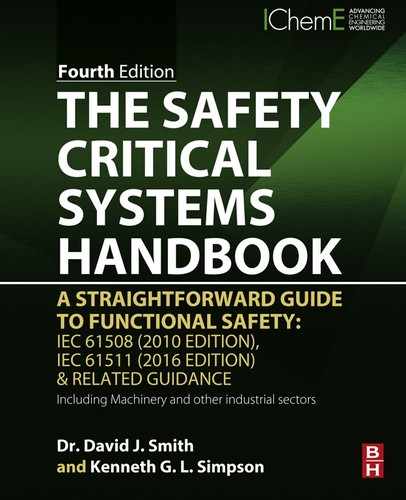Machinery Sector
Abstract
This chapter may seem to describe a different “rule-based” graph-type approach to the methods encouraged throughout this book. It has to be said that the authors believe these to be not fully “calibrated” (i.e., dimensioned) against assessments from comparative quantified risk assessment approaches or from field failure data. However, the methods have stood the test of considerable use and thus represent a benchmark which has become acceptable throughout the sector.
Keywords
This chapter may seem to describe a different “rule-based” graph-type approach to the methods encouraged throughout this book. It has to be said that the authors believe these to be not fully “calibrated” (i.e., dimensioned) against assessments from comparative quantified risk assessment approaches or from field failure data.
However, the methods have stood the test of considerable use and thus represent a benchmark which has become acceptable throughout the sector.
9.1. EN ISO 12100:2010
9.2. EN ISO 13849
![]()

The Assessment
![]()
| Assessment | Range of MTTFd per channel |
| Low | 3 years ≤ MTTFd < 10 years |
| Medium | 10 years ≤ MTTFd < 30 years |
| High | 30 years ≤ MTTFd < 100 years |
| Category | B | 1 | 2 | 2 | 3 | 3 | 4 |
| DCav | None | None | Low | Medium | Low | Medium | High |
| MTTFd per channel: | |||||||
| Low | a | Not covered | a | b | b | c | Not covered |
| Medium | b | Not covered | b | c | c | d | Not covered |
| High | Not covered | c | c | d | d | d | e |

9.2.1. Systematic Failures
9.3. BS EN 62061
9.3.1. Targets
SIL assignment
| Frequency and duration, Fr | Probability of hazard event, Pr | Avoidance, Av | |||
| ≤1 hrs | 5 | Very high | 5 | ||
| >1 hrs–≤1 day | 5 | Likely | 4 | ||
| >1 day–≤2 weeks | 4 | Possible | 3 | Impossible | 5 |
| >2 weeks–≤1 year | 3 | Rarely | 2 | Possible | 3 |
| >1 year | 2 | Negligible | 1 | Likely | 1 |

| Consequence | Severity (Se) | Class Cl = Fr + Pr + Av | ||||
| Classes 3–4 | Classes 5–7 | Classes 8–10 | Classes 11–13 | Classes 14–15 | ||
| Death, losing eye or arm | 4 | SIL2 | SIL2 | SIL2 | SIL3 | SIL3 |
| Permanent, losing fingers | 3 | (OM) | SIL1 | SIL2 | SIL3 | |
| Reversible, medical attention | 2 | (OM) | SIL1 | SIL2 | ||
| Reversible, first aid | 1 | (OM) | SIL1 | |||

9.3.2. Design
9.3.3. Template Assessment Checklist for BS EN 62061
Clause 4 Management of Functional Safety

Clause 5 Requirements for the Specification of Safety-Related Control Functions (SRCFs)

Clause 6 Design and Integration of the SRECS



Clause 7 Information for Use of the SRECS

Clause 8 Validation of the SRECS

Clause 9 Modification













